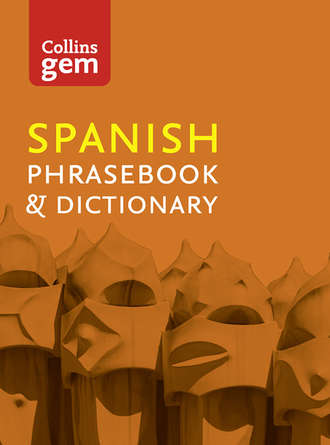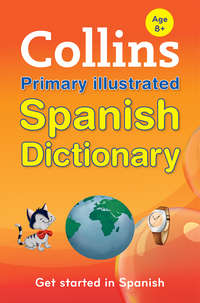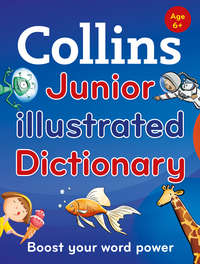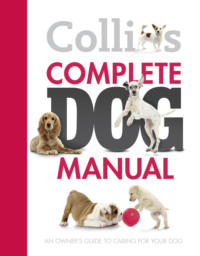
Полная версия
Collins Gem
Work
What work do you do?¿En qué trabaja? ¿en ke tra-ba-kha?Do you enjoy it?¿Le gusta? ¿le goosta?I’m…Soy… soy…a doctormédico(a) me-dee-ko(a)a teacherprofesor(a) pro-fe-sor(a)a secretarysecretaria se-kre-ta-ryaI’m self-employedSoy autónomo soy ow-tonomoWeather
los chubascos los choo-bas-kosshowersdespejado des-pe-kha-doclearla lluvia la lyoobyarainla niebla la nye-blafognublado noo-bla-docloudy It’s sunnyHace sol a-the solIt’s rainingEstá lloviendo esta lyo-byen-doIt’s snowingEstá nevando esta ne-ban-doIt’s windyHace viento a-the byentoWhat a lovely day!¡Qué día más bueno! ¡ke dee-a mas bwe-no!What awful weather!¡Qué tiempo tan malo! ¡ke tyempo tan ma-lo!What will the weather be like tomorrow?¿Qué tiempo hará mañana? ¿ke tyempo a-ra ma-nya-na?Do you think it’s going to rain?¿Cree que va a llover? ¿kre-e ke ba a lyo-bair?It’s very hotHace mucho calor a-the moocho ka-lorDo you think there will be a storm?¿Cree que va a haber tormenta? ¿kre-e ke ba a a-bair tor-men-ta?Do you think it will snow?¿Le parece que va a nevar? ¿le pa-re-the ke ba a ne-bar?What is the temperature?¿Qué temperatura hace? ¿ke tem-pe-ra-too-ra a-the?Getting around
Asking the way
enfrente (de) en-fren-te (de)opposite (to)al lado de al la-do denext tocerca de thairka denear toel semáforo el se-ma-fo-rotraffic lightsen la esquina en la es-kee-naat the cornerFACE TO FACE
Oiga, señor/señora, ¿cómo se va a la estación?
oyga, se-nyor/se-nyo-ra, ¿ko-mo se ba a la es-ta-thyon?
Excuse me, how do I get to the station?
Siga recto, después de la iglesia gire a la derecha/izquierda
seega rekto, despwes de la ee-gle-sya kheere a la de-re-cha/eeth-kyair-da
Keep straight on, after the church turn right/left
¿Está lejos? ¿esta le-khos?
Is it far?
No, a doscientos metros/cinco minutos
no, a dos-thyen-tos me-tros/theenko mee-noo-tos
No, 200 metres/five minutes
Gracias! gra-thyas! Thank you!
De nada
de na-da
You’re welcome
We’re looking for…Estamos buscando… es-ta-mos boos-kan-do…Is it far?¿Está lejos? ¿esta le-khos?Can I/we walk there?¿Se puede ir andando? ¿se pwe-de eer an-dan-do?How do I/we get to the centre of (name of town)?¿Cómo se va al centro de…? ¿ko-mo se ba al thentro de…?We’re lostNos hemos perdido nos e-mos pair-dee-doCan you show me where it is on the map?¿Puede indicarme dónde está en el mapa? ¿pwe-de een-dee-kar-me donde esta en el ma-pa? YOU MAY HEAR…Después de pasar el puente despwes de pa-sar el pwenteAfter passing the bridgeGire a la izquierda/derecha kheere a la eeth-kyair-da/de-re-chaTurn left/rightSiga todo recto hasta llegar a… seega to-do rekto asta lye-gar a…Keep straight on until you get to…Bus and coach
The word for bus is el autobús but a coach is el autocar. A bonobús card is usually valid for 10 journeys and must be stamped on board the bus. Bonobús is the general term for a travel card but some cities have a different name for these (Madrid = metrobús, Barcelona = T-10). Public transport is usually free for children under 4. In most cities, children over 4 pay the full adult fare, with the occasional discount if you have purchased a tourist pass.
FACE TO FACE
Oiga, ¿qué autobús va al centro?
oyga, ¿ke ow-to-boos ba al thentro?
Excuse me, which bus goes to the centre?
El número quince
el noo-me-ro keenthe
Number fifteen
¿Dónde está la parada?
¿donde esta la pa-ra-da?
Where is the bus stop?
Allí, a la derecha
a-lyee, a la de-re-cha
There, on the right
¿Dónde puedo comprar un bonobús?
¿donde pwe-do komprar oon bo-no-boos?
Where can I buy a bonobus card?
En el kiosko
en el kee-os-ko
At the news-stand
Is there a bus to…?¿Hay algún autobús que vaya a…? ¿aee algoon ow-to-boos ke ba-ya a…?Where do I catch the bus to…?¿Dónde se coge el autobús para…? ¿donde se ko-khe el ow-to-boos pa-ra…?to the centreal centro al thentroto the beacha la playa a la pla-yato the airportal aeropuerto al a-e-ro-pwair-toto Toledoa Toledo a to-le-doHow often are the buses to…?¿Cada cuánto hay autobuses a…? ¿ka-da kwanto aee ow-to-boo-ses a…?When is the first/the last bus to…?¿Cuándo sale el primer/el último autobús para…? ¿kwando sa-le el preemair/el ool-tee-mo ow-to-boos pa-ra…?Please tell me when to get offPor favor, ¿me dice cuándo tengo que bajarme? por fa-bor, ¿me deethe kwando tengo ke ba-khar-me?A child’s ticketUn billete de niño oon bee-lye-te de neenyocoacheconómica e-ko-no-meekashuttle busel bus lanzadera boos lan-tha-dera YOU MAY HEAR…Este autobús no para en… este ow-to-boos no pa-ra en…This bus doesn’t stop in…Tiene que coger el… tye-ne ke ko-khair el…You have to catch the…Metro
You can buy un billete múltiple (known as metrobús in Madrid or T-10 in Barcelona), which is valid for 10 journeys. Alternatively, you can buy un abono de transporte, which covers a month’s travel on bus and metro. Barcelona, Bilbao, Madrid, Málaga, Palma de Mallorca, Seville and Valencia are currently the only Spanish cities with a metro system.
la entrada la en-tra-daentrancela salida la sa-lee-daway out/exit Where is the nearest metro station?¿Dónde está la estación de metro más cercana? ¿donde esta la es-ta-thyon de me-tro mas thair-ka-na?A metrobus ticket pleaseUn metrobús, por favor oon me-tro-boos por fa-borDo you have a map of the metro?¿Tiene un plano del metro? ¿tye-ne oon pla-no del me-tro?How do I/we get to…?¿Cómo se va a…? ¿ko-mo se ba a…?Do I have to change?¿Tengo que cambiar de línea? ¿tengo ke kambyar de lee-ne-a?What is the next stop?¿Cuál es la próxima parada? ¿kwal es la prok-see-ma pa-ra-da?Train
High-speed train tickets can seem a bit confusing. On an AVE train there are three travel classes: Club (equivalent to business class), Preferente (also equivalent to business class) and Turista (equivalent to economy class). Then, there are four types of fares that apply to each class: Promo (the fare with the most restrictions), Promo+ (which offers big discounts), Tarifa 4 Mesa (for four people travelling together and sharing seats around the same table) and Flexible (the fare with the least number of restrictions). A useful website is www.renfe.es.
sencillo sen-thee-lyosingle/one-wayida y vuelta eeda ee bweltareturnel horario el o-ra-ryotimetablesalidas sa-lee-dasdeparturesllegadas lye-ga-dasarrivalsdiario dee-a-ryodailyel billete electrónico el bee-lye-te e-lek-tro-neekoe-ticketla reserva electrónica la re-sair-ba e-lek-tro-neekae-bookingel andén el andenplatformFACE TO FACE
¿A qué hora es el próximo tren para…?
¿a ke o-ra es el prok-see-mo tren pa-ra…?
When is the next train to…?
A las cinco y diez
a las theenko ee dyeth
At 17.10
Querría tres billetes, por favor
ke-rree-a tres bee-lye-tes, por fa-bor
I’d like three tickets, please
¿Sencillos o de ida y vuelta?
¿sen-thee-lyos o de eeda ee bwelta?
Single or return?
Where is the station?¿Dónde está la estación? ¿donde esta la es-ta-thyon?Two return tickets to…Dos billetes de ida y vuelta a… dos bee-lye-tes de eeda ee bwelta a…A single to…Un billete de ida a… oon bee-lye-te de eeda a…Tourist classDe clase turista de kla-se too-rees-taIs there a supplement to pay?¿Hay que pagar suplemento? ¿aee ke pa-gar soo-ple-men-to?I would like a ticket on the AVE to SevilleQuerría un billete en el AVE a Sevilla ke-rree-a oon bee-lye-te en el a-be a se-bee-lyaWhen is the first/last train to…?¿Cuándo es el primer/último tren para…? ¿kwando es el preemair/el ool-tee-mo tren pa-ra…?Do I have to change?¿Tengo que hacer transbordo? ¿tengo ke a-thair trans-bor-do?Where?¿Dónde? ¿donde?Which platform does it leave from?¿De qué andén sale? ¿de ke anden sa-le?Is this the train for…?¿Es este el tren para…? ¿es este el tren pa-ra…?When will it leave?¿Cuándo saldrá? ¿kwando saldra?Does the train stop at…?¿Para el tren en…? ¿pa-ra el tren en…?When does it arrive in…?¿Cuándo llega a…? ¿kwando lye-ga a…?Please let me know when we get to…Por favor, ¿me avisa cuando lleguemos a…? por fa-bor, ¿me a-bee-sa kwando lye-ge-mos a…?Is this free? (seat)¿Está libre? ¿esta leebre?Excuse me¡Perdón! ¡pairdon!I booked onlineLo reservé por internet lo re-sair-be por een-ter-netTaxi
In most places, taxis are plentiful, reliable and not very expensive. The meter should be running unless there is a fixed fare (as is the case from some airports). Fare supplements may be added to the meter price for journeys at night, at weekends or for station/airport departures. Prices should be displayed on the inside window of the taxi.
I need a taxiNecesito un taxi ne-the-see-to oon takseeWhere is the taxi stand?¿Dónde está la parada de taxis? ¿donde esta la pa-ra-da de taksees?straightawayenseguida en-se-gee-dafor (time)para las… pa-ra las…How much is the taxi fare…?¿Cuánto cuesta ir en taxi…? ¿kwanto kwesta eer en taksee…?into townal centro al thentroto the hotelal hotel al o-telto the stationa la estación a la es-ta-thyonto the airportal aeropuerto al a-e-ro-pwair-toto this addressa esta dirección a esta dee-rek-thyonPlease take me/us to…¿Me/Nos lleva a … por favor? ¿me/nos lye-ba a … por fa-bor?Keep the changeQuédese con la vuelta ke-de-se kon la bweltaSorry, I don’t have any changeLo siento, no tengo nada de cambio lo syento, no tengo na-da de kambyoBoat and ferry
la travesía la tra-be-see-acrossingel crucero el kroo-the-rocruiseel camarote el ka-ma-ro-tecabin When is the next boat/ferry to…?¿Cuándo sale el próximo barco/ferry para…? ¿kwando sa-le el prok-see-mo barko/ferry pa-ra…?Have you a timetable?¿Tienen un horario? ¿tye-nen oon o-ra-ryo?Is there a car ferry to…?¿Hay ferry para coches a…? ¿aee ferry pa-ra ko-ches a…?How much is a ticket…?¿Cuánto cuesta el billete…? ¿kwanto kwesta el bee-lye-te…?singlesencillo/de ida sen-thee-lyo/de eedareturnde ida y vuelta de eeda ee bweltaHow much is the crossing for a car and … people?¿Cuánto cuesta un pasaje para … personas y un coche? ¿kwanto kwesta oon pa-sa-khe pa-ra … pair-so-nas ee oon ko-che?How long is the journey?¿Cuánto dura el viaje? ¿kwanto doora el bya-khe?What time do we get to…?¿A qué hora llegamos a…? ¿a ke o-ra lye-ga-mos a…?Where does the boat leave from?¿De dónde sale el barco? ¿de donde sa-le el barko?When is the first/the last boat?¿Cuándo sale el primer/el último barco? ¿kwando sa-le el preemair/el ool-tee-mo barko?Air travel
The top three major Spanish airports are Aeropuerto Adolfo Suárez Madrid-Barajas, Aeropuerto Barcelona-El Prat and Aeropuerto de Palma de Mallorca.
How do I get to the airport?¿Cómo se va al aeropuerto? ¿ko-mo se ba al a-e-ro-pwair-to?To the airport, pleaseAl aeropuerto, por favor al a-e-ro-pwair-to, por fa-borIs there a bus to the airport?¿Hay algún autobús al aeropuerto? ¿aee algoon ow-to-boos al a-e-ro-pwair-to?How do I/we get to the centre of…?¿Cómo se va al centro de…? ¿ko-mo se ba al thentro de…?Where is the luggage for the flight from…?¿Dónde está el equipaje del vuelo de…? ¿donde esta el e-kee-pa-khe del bwe-lo de…?Where can I print my ticket?¿Dónde puedo imprimir el billete? ¿donde pwe-do eem-pree-meer el bee-lye-te?I have my boarding pass on my smartphoneLlevo la tarjeta de embarque en el móvil lye-vo la tar-khe-ta de em-bar-ke en el mo-beelchecked luggageel equipaje facturado el e-kee-pa-khe fak-too-radohand luggageel equipaje de mano el e-kee-pa-khe de ma-no YOU MAY HEAR…El embarque se efectuará por la puerta número… el em-bar-ke se e-fek-twa-ra por la pwairta noo-me-ro…Boarding will take place at gate number…Última llamada para los pasajeros del vuelo…ool-tee-ma lya-ma-da pa-ra los pa-sa-khe-ros del bwe-lo…Last call for passengers on flight number…Su vuelo sale con retraso soo bwe-lo sa-le kon re-tra-soYour flight is delayedLíquidos prohibidos lee-kee-dos pro-ee-bee-dosNo liquidsSu equipaje supera el peso máximo soo e-kee-pa-khe soo-pera el pe-so mak-see-moYour luggage exceeds the maximum weightCustoms control
Flights between countries belonging to the Schengen Agreement are considered as domestic. Passengers taking those flights will not be subject to immigration controls on arrival or departure. The UK is not part of this, so arrivals from the UK are subject to immigration controls.
la UE la oo ehthe EUla aduana la a-doo-a-nacustoms controlel pasaporte el pa-sa-por-tepassport Do I have to pay duty on this?¿Tengo que pagar derechos de aduana por esto? ¿tengo ke pagar de-re-chos de a-doo-a-na por esto?It is for my own personal useEs para uso personal es pa-ra ooso pair-so-nalWe are on our way to… (if in transit through a country)Estamos aquí de paso, vamos a… es-ta-mos a-kee de pa-so, ba-mos a…Car hire
Car rental companies in Spain can set a minimum age for hiring a car (usually 21 or 23, depending on the company and type of vehicle). When you go to hire the car, most companies will ask for a valid credit card where a temporary deposit will be charged.
el permiso de conducir el pair-mee-so de kon-doo-theerdriving licenceel seguro el se-goo-roinsurancela marcha atrás la marcha a-trasreverse gear I want to hire a carQuerría alquilar un coche ke-rree-a al-kee-lar oon ko-chefor … days/the weekendpara … días/el fin de semana pa-ra … deeas/el feen de se-ma-naWhat are your rates…?¿Qué tarifas tienen…? ¿ke ta-ree-fas tye-nen…?per daypor día por deeaper weekpor semana por se-ma-naIs there a mileage (km) charge?¿Hay que pagar kilometraje? ¿aee ke pa-gar kee-lo-me-tra-khe?How much?¿Cuánto? ¿kwanto?Is fully comprehensive insurance included in the price?¿El seguro a todo riesgo va incluido en el precio? ¿el se-goo-ro a to-do ryesgo ba een-kloo-ee-do en el pre-thyo?Do I have to return the car here?¿Tengo que devolver el coche aquí mismo? ¿tengo ke de-bol-bair el ko-che a-kee meesmo?By what time?¿Para qué hora? ¿pa-ra ke o-ra?I’d like to leave it in…Quisiera dejarlo en… kee-sye-ra de-khar-lo en…Can you show me how the controls work?¿Me enseña cómo funcionan los mandos? ¿me en-se-nya ko-mo foon-thyo-nan los mandos? YOU MAY HEAR…Por favor, devuelva el coche con el depósito lleno por fa-bor, de-bwelba el ko-che kon el de-po-see-to lye-noPlease return the car with a full tank






